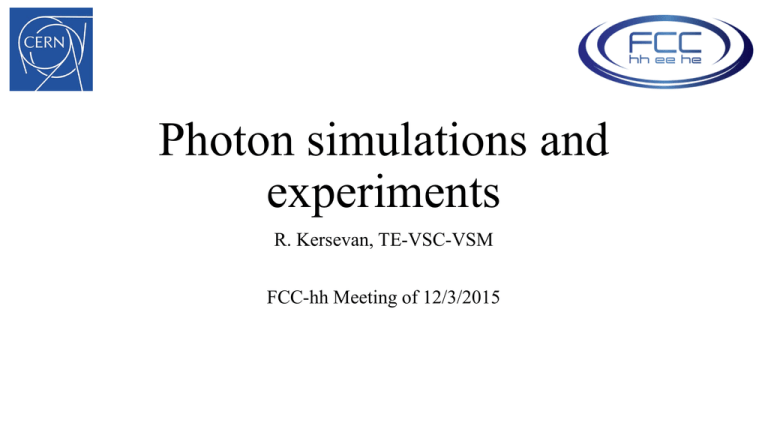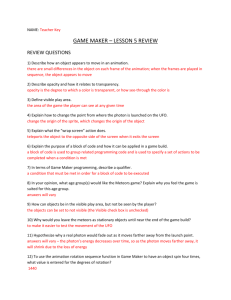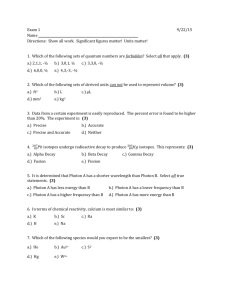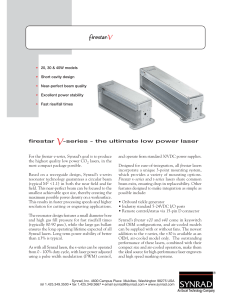Progress of the Beam Screen Design - Indico
advertisement

Photon simulations and experiments R. Kersevan, TE-VSC-VSM FCC-hh Meeting of 12/3/2015 • For challenging machines like FCC-hh it is becoming more and more important to be able to simulate efficiently and accurately the synchrotron radiation (SR) photon distribution along the machine, with realistic physically-accurate scattering and absorption effects. • A starting point is to calculate accurately the SR photon spectra • It is then interesting to consider the fact that the 4 eV cut-off photon energy for SR-induced desorption and photo-electron (PE) generation is such to introduce an apparent increase of the desorption yield and PE generation • … which has an effect on the apparent increase of molecular desorption (and possibly PE generation as well) as the beam energy is increased, with respect to the desorption (and eventually PE) at low energy, using the usual scaling of the energy (SR photon flux F~ E (GeV), and Eph>4 eV for Ebeam> 5 TeV)) • Detailed 3D MC simulations can be run for both the SR and the attendant molecular flow • The amount of experimental data for the photo-desorption yield at cryogenic temperature are scant and badly missing: some had been taken at EPA, with a photon critical energy of 194 eV (see for instance https://cds.cern.ch/record/585781/files/lhc-project-report-607.pdf?version=1 , O. Groebner et al.), some more had been measured at the time of the SSC (and the VLHC following the SSC demise) with the help of BINP’s facilities (P. Bauer et al., FNAL; V. Anashin et al., BINP; W.C. Turner LLNL), but since there has not been much done at all, due to the peculiarity and uniqueness of the LHC accelerator environment. • For FCC-hh we cannot possibly think of designing the machine without a serious program of measurement and systematic study of all of the different variables (see talk by R. Cimino, this meeting). • Apart from the surface and material parameter study program, we also need a test on a suitable SR light source of a reasonably-sized mockup of the beam-screen (BS) design, like done on the COLDEX experiment. It is important to have available a SR source with a photon spectrum and power density close to the one for FCChh ( ~ 4 keV, 25 W/m). • Let’s look at how are presently dealt with the reflectivity and surface roughness scattering in SYNRAD+: (next 4 slides courtesy of Marton Ady, CERN/EPFL) Material surface reflection in Synrad+ First step: determine if photon reflected or absorbed Incident angle Grazing angle Grazing angles [mrad] Reflection probability [%] Reflection probability depends on angle of incident and energy Particle energy [eV] Data from: Berkeley Lab / Center for X-ray optics ; henke.lbl.gov Presently there is an effort into extending to lower and higher energies the reflectivity data using the Fresnel formulation, as per literature. Second step: if reflected, determine new direction Specular reflection N N N Introducing roughness We still assume specular reflection, but due to the surface roughness, we perturbate the surface normal Mirror reflection Determine new surface normal N N N Normal V U The user sets surface roughness “sigmaRatio” Equal to RMS cavity depth / surface correlation length Two random rotations around U, V vectors 𝜃𝑜𝑓𝑓𝑠𝑒𝑡 = 𝑡𝑎𝑛−1 𝑠𝑖𝑔𝑚𝑎𝑅𝑎𝑡𝑖𝑜 ∗ tan 𝑅𝑁𝐷−𝜋…+𝜋 2 2 𝜑𝑜𝑓𝑓𝑠𝑒𝑡 = 𝑡𝑎𝑛−1 𝑠𝑖𝑔𝑚𝑎𝑅𝑎𝑡𝑖𝑜 ∗ tan 𝑅𝑁𝐷−𝜋…+𝜋 2 In Synrad, each facet has a normal vector, and also two local U,V vectors in its plane 2 uniform RND number between –PI/2 and +PI/2 𝜃𝑜𝑓𝑓𝑠𝑒𝑡 = 𝑡𝑎𝑛−1 𝑠𝑖𝑔𝑚𝑎𝑅𝑎𝑡𝑖𝑜 ∗ tan 𝑅𝑁𝐷−𝜋…+𝜋 2 𝜑𝑜𝑓𝑓𝑠𝑒𝑡 = 𝑡𝑎𝑛 1. Rotation around U by thetaOffset 2. Rotation around V by phiOffset 3. not enough: non-isotropic −1 2 𝑠𝑖𝑔𝑚𝑎𝑅𝑎𝑡𝑖𝑜 ∗ tan 𝑅𝑁𝐷−𝜋…+𝜋 2 2 4. Rotation around N to restore isotropy 4. With the new surface normal calculated, we execute the specular reflection 5. We rejects photons that would “come from the back” or “reflect towards the back” (shadowing) -> in these cases we generate a new random surface angle (corresponding to second reflection) FCC-hh: LHC-type BS ray-tracing analysis (1 dipole only, periodic boundary conditions) FCC-hh: new type of BS (with separate SR absorber) Ray-tracing analysis (1 dipole only, periodic boundary conditions) Going from SR ray tracing (SYNRAD+) to molecular flow (Molflow+) • First step is to transform the photon distribution along the vacuum chamber surface into molecular yield • Due to the scarcity of cryogenic measurements at the correct critical energy, we use room-temperature data, as in “Photon‐stimulated desorption yields from stainless steel and copper‐plated beam tubes with various pretreatments - CL Foerster et al - JVST A8 1990 p2856”, Journal of Vacuum Science and Technology A 8 (1990) p2856 • … which has been digitized and used for the design/upgrade of the 6 GeV APS light source (courtesy of J. Carter, APS)… Conclusions: Software tools already exist for what concerns the SR and molecular flow simulations: Molflow+ has been validated against tens of cases/studies published on peer-reviewed journals. It is fully 3D and includes thermal accommodation factors and “automatic” consideration of thermal transpiration effects, plus (if necessary) time-dependent transients; SYNRAD+ is being validated against measurements on SR light source beamlines and machines (R. Kersevan, ESRF; M. Ady, Photon Factory/KEK). It is also fully 3D and takes into account beam sizes, emittances, etc… A serious, well planned, well funded, R&D program for measuring with some precision the surface parameters of real beam-screen materials, including reflectivity data, photo-electron yield and SEY, is necessary. These can/will be used as input for 3D ray-tracing simulations, possibly helping the e-cloud community in its effort to curb e-cloud issues A dedicated experiment on a SR light source with a 1-2 m long BS configuration under real cryogenic conditions is necessary







